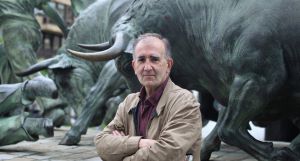
Photo of Miguel Izu, from Foto Calleja, taken from Miguel Izu's blog
In its Fall 2021 (Volume 41, Number 1) issue, The Hemingway Review published a review by Iñaki Sagarna (DOI: https://doi.org/10.1353/hem.2021.0025) of my book Hemingway en los sanfermines.
This review contains some statements about my book that do not correspond to reality. It is surprising that Sagarna attributes to me opinions that I have not expressed and that I do not hold at all.
On page 115 of his article he writes:
He accuses Hemingway of propagating somehow a way of understanding the fiesta that perverts sexually the nature of San Fermín. Supposedly, Hemingway enabled the creation of a mind-set that contributed to the rise of sexual abuse during the fiesta (212). This idea was already raised by Santiago Cervera at El abrevadero de La Manada, and it corresponds to the ambivalent reception of Hemingway’s figure. By raising such an argument, incomprehensibly, Izu blames Hemingway even for violent acts perpetrated by Spaniards in the 21st century, or at least blames Hemingway for creating the atmosphere for such violent acts.
And on page 116 he states:
There is a prevailing prejudice against Hemingway in some of the circles of Pamplona, and Izu is clearly in it. He attempts to minimize any positive impact on Hemingway. For example, even though Izu argues that San Fermín would become internationally known due to the mass tourism that began in the 1920s, incomprehensibly he blames Hemingway for the massification of the fiesta.
Everything I wrote about this matter, and any unprejudiced reader can check with their own eyes, is the following:
Por otro lado, el juicio de los pamploneses de hoy sobre Hemingway resulta ambiguo. Lo hemos adoptado como una especie de mascota de la ciudad, pero no tenemos claro si amarle o aborrecerle, si con su difusión internacional de los sanfermines, con su masificación, nos hizo un favor o una faena. (page 203)
Como escribió García Serrano, Hemingway devino en “el mejor agente publicitario de las ferias y fiestas de San Fermín”. Algo que, ya se ha mencionado, muchos pamploneses consideran como un mérito, pero que otros ven como un flaco favor a la ciudad a la vista de la masificación y desnaturalización de las fiestas de la que hacen responsable, al menos parcialmente, al escritor, incluida la fama de una supuesta permisividad sexual que ha facilitado demasiados casos de abusos y violaciones, los cuales han producido gran conmoción social en los primeros años de este siglo. (page 212)
The reader who does not understand Spanish can refer to the English translation by Martín Roberts (Hemingway in Pamplona, Amazon Digital Services, 2021, https://www.amazon.es/Hemingway-Pamplona-Miguel-Izu/dp/B08YQQWW17):
Meanwhile, Pamplona folk today are in two minds about Hemingway. We have adopted him as a sort of city mascot, but are not sure whether to love or hate him, whether by publicizing the sanfermines the world over, and all the overcrowding, he did us a favor, or a disservice. (page 175)
As García Serrano wrote, Hemingway became: ‘the best advertising agent for the fair and Festival of Saint Fermin.’ Something that, as mentioned above, some Pamplona folk see as a favor while others deem it a disservice to the city, in view of how the festival has become distorted and overcrowded, for which they blame the writer, at least in part, as well as the reputation of a supposed sexual permissiveness that has given rise to too many cases of abuse and rape, which have caused a great uproar in the early years of this century. (page 182)
In my book I collect the opinions of many people, but it should not be necessary to specify that I do not share all of them. Iñaki Sagarna has not known, or has not wanted, to understand what my true opinions are.
Miguel Izu, born in Pamplona in 1960, holds a doctorate in law and a degree in politics and sociology. He has practiced law and been associate professor of administrative law at the University of Navarre and the Public University of Navarre, served as a member of the Pamplona City Council, president of the Pamplona District Council, and member of the Navarre Parliament and of the Navarre Administrative Court. His publications include Hemingway in Pamplona, translated by Martin Roberts.